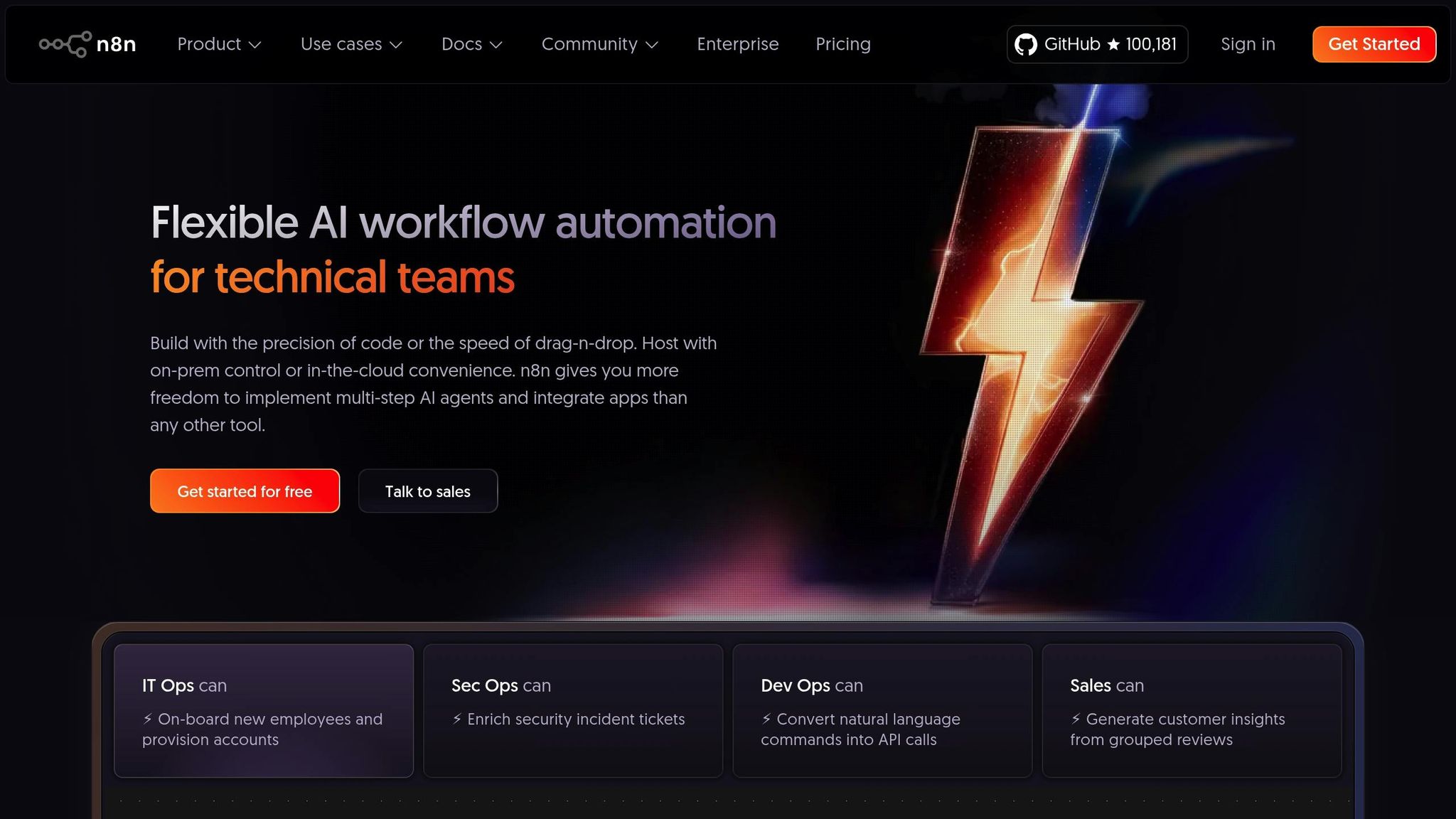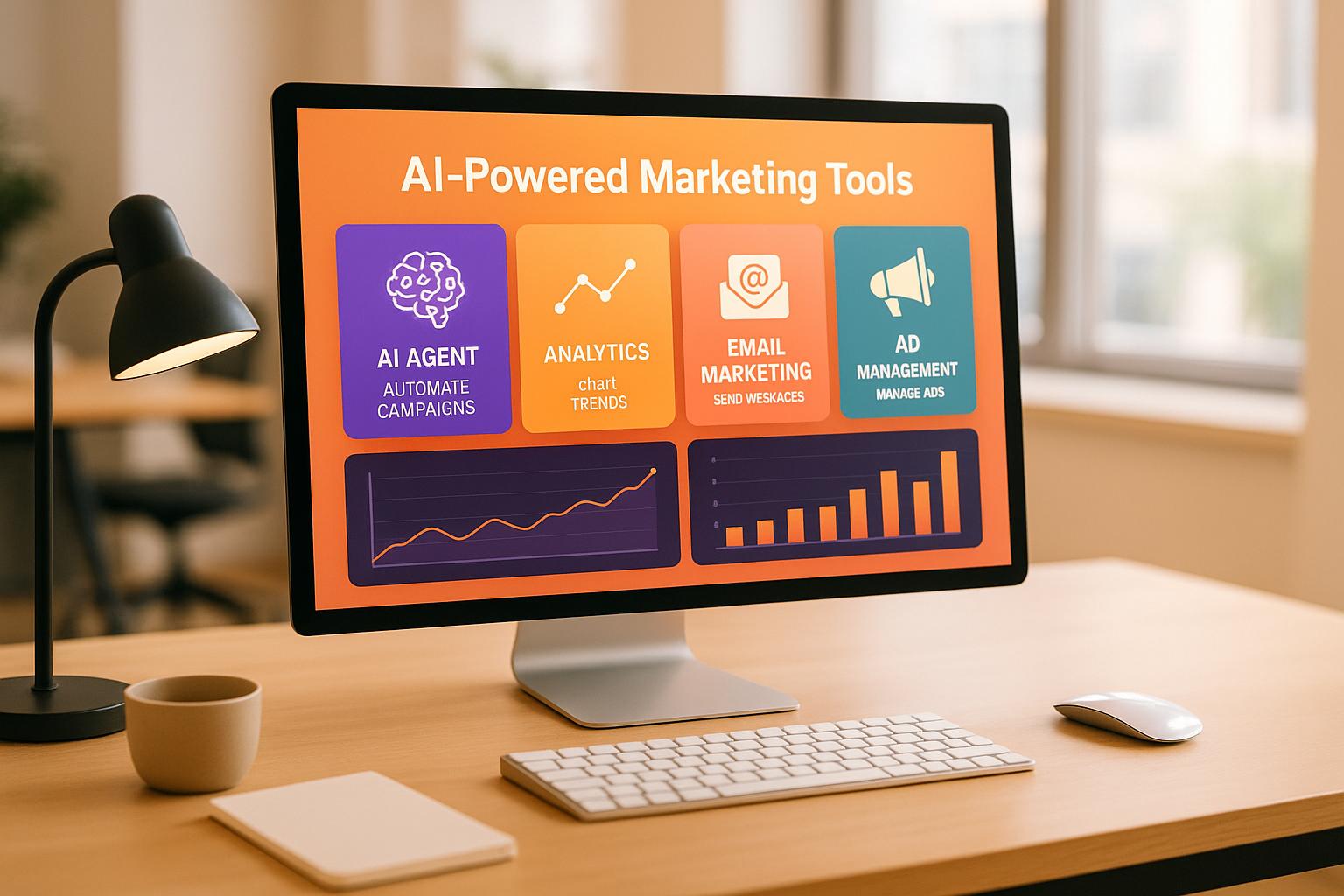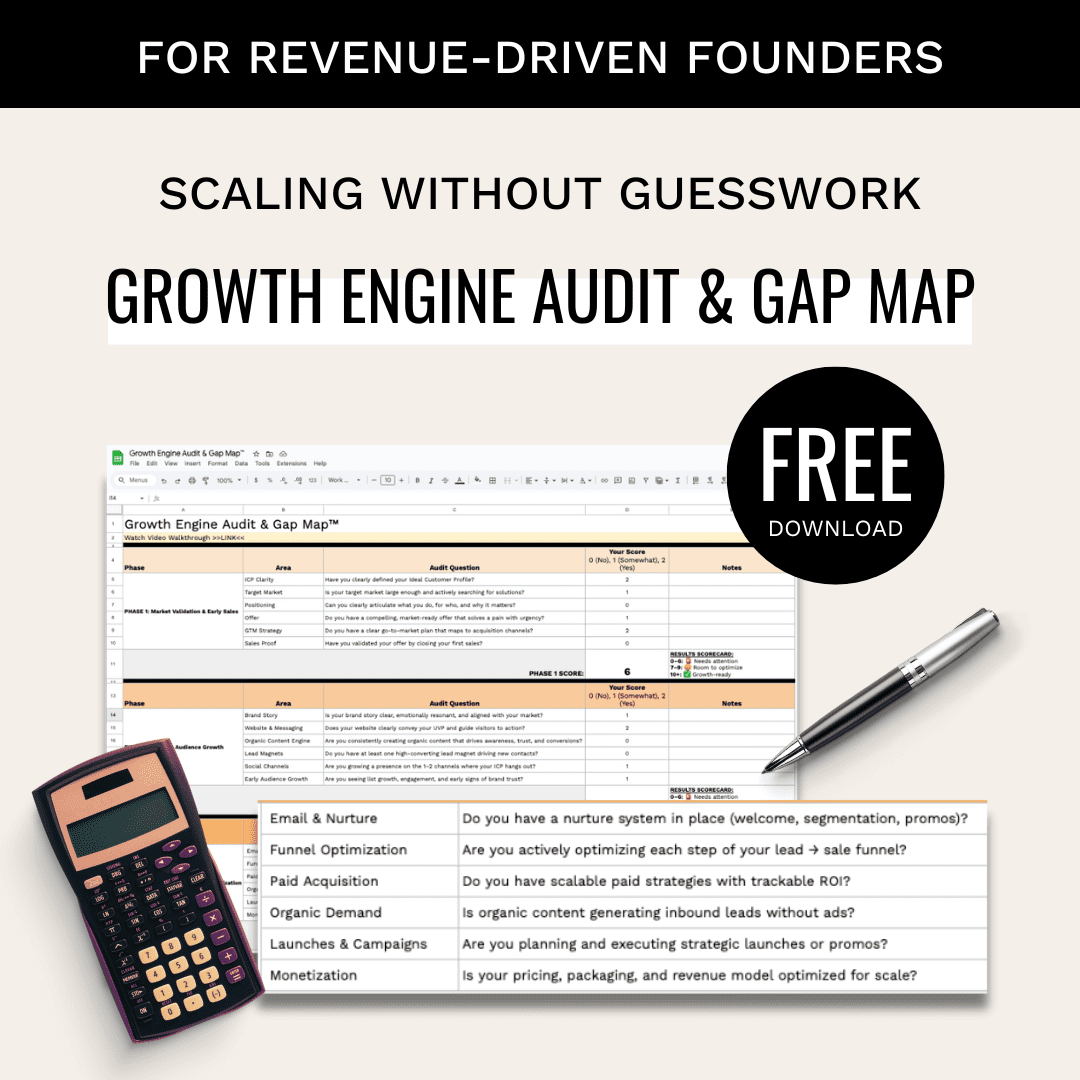Vibe coding is changing marketing by simplifying complex tasks with AI-powered, no-code tools. These tools allow marketers to automate workflows, create personalized content, and manage campaigns without technical expertise. Here’s a quick overview of what you’ll find in this article:
- What is Vibe Coding? AI-driven, no-code platforms that automate tasks.
- Why it Matters: Saves time, reduces costs, and improves efficiency.
- Top Tools: Jasper AI for copywriting, Notion AI for collaboration, Gumloop for automation, and more.
- Use Cases: Automating lead nurturing, creating content faster, and personalizing customer experiences.
- How to Choose the Right Tool: Focus on ease of use, integration, scalability, and cost.
Quick Comparison of Key Tools
| Tool Category | Example Tools | Best For | Starting Cost |
|---|---|---|---|
| Content Creation | Jasper AI, Notion AI | Writing and repurposing content | $8/month |
| Marketing Automation | Gumloop, Zapier | Workflow automation | $20/month |
| Personalization Platforms | Albert.ai, Algolia | Real-time targeting | Varies by platform |
| Analytics & Optimization | FullStory, Brand24 | Tracking performance | Varies by platform |
Key Insight: Vibe coding tools are reshaping marketing by enabling faster, smarter, and more scalable campaigns. Start small, focus on high-impact tasks, and leverage AI to stay ahead.
I Built a Marketing Team with 1 AI Agent and No Code (free n8n template)

Top Vibe Coding Tools for Marketing in 2025
As vibe coding continues to shape the marketing world, a range of tools has emerged to simplify complex workflows. These platforms blend automation with user-friendly interfaces, making advanced marketing strategies more accessible.
Content Creation and Repurposing Tools
When it comes to content creation, vibe coding tools are a natural fit. Jasper AI is a standout, known for its ability to craft polished copy for emails and social media. With over 5,000 five-star reviews, it’s a trusted choice for maintaining a consistent brand voice across various content types.
Notion AI, on the other hand, integrates content generation into project management. Priced at $8-10 per member per month, it’s perfect for teams needing a combination of document creation, collaboration tools, and AI-driven writing assistance.
For visual content, Lexica Art creates blog thumbnails and marketing graphics, while PhotoRoom handles batch background removal for e-commerce and social media visuals. These tools are essential for brands aiming to streamline their design processes.
For SEO-focused content, Brandwell automates blog post research and writing, while ContentShake AI goes further by incorporating keyword optimization and offering structural recommendations for blog posts.
"AI is the next step in business automation. AI had been instrumental in improving business processes. AI can be deployed to an organization’s business process for a particular strategic purpose to increase efficiencies, cut costs and improve customer service." – Jasper AI
Marketing Automation and Workflow Builders
Automation tools are at the heart of vibe coding, enabling seamless workflow management. Gumloop is a modern solution that connects tools like GPT-4, Claude, and Grok to your internal systems without requiring coding knowledge.
For simpler automation, Zapier remains a go-to platform, linking thousands of apps through straightforward trigger-and-action workflows. Teams looking for more advanced features can explore n8n, which offers a self-hosting option starting at €20 per month for up to 2,500 executions.
In customer engagement, Chatfuel builds chatbots to handle inquiries, while Reply.io‘s AI Sales Email Assistant automates email responses and follow-ups. For data collection, Browse AI scrapes competitor websites, social media, and industry sites, providing valuable insights for marketing strategies.
Personalization and Segmentation Platforms
Personalization tools use AI to deliver tailored experiences. Albert.ai specializes in optimizing digital advertising campaigns by adjusting parameters in real-time based on performance metrics.
Algolia provides search and recommendation APIs that enhance website personalization, making it easier for visitors to find relevant products or content. This is especially useful for e-commerce and content-driven platforms.
For large-scale customer segmentation and messaging, Agentforce by Salesforce integrates deeply with CRM systems, enabling sophisticated customer journey automation.
Analytics and Optimization Tools
Analytics tools are essential for refining marketing strategies. FullStory captures detailed customer behavior data, simplifying the process of identifying patterns and improving user experiences.
Brand24 monitors brand mentions across social media, news outlets, and forums, using AI to analyze sentiment and highlight trending topics. This helps marketers stay ahead of conversations relevant to their campaigns.
For influencer marketing, Influencity provides analytics to identify ideal partnerships and track campaign results. Meanwhile, Originality AI ensures content authenticity by detecting AI-generated material, and Undetectable AI refines such content to make it more human-like when necessary.
These tools collectively enhance the precision of marketing campaigns, creating a solid strategy for vibe coding. With the no-code industry projected to hit $65 billion by 2027, marketers are gaining access to tools that deliver enterprise-level functionality without requiring technical expertise or hefty budgets.
"AI agents are getting smarter and more capable every day. The key to success? Start working with them now, but do it thoughtfully. Begin with specific tasks where they can make the biggest difference. Learn from experience." – ContentGrow
Practical Use Cases for Vibe Coding in Marketing
The practical applications of vibe coding tools are reshaping how marketing teams operate. By automating tasks that once demanded significant manual effort and large teams, these tools are driving measurable results and boosting efficiency.
Automating Lead Nurturing and Follow-Ups
One of the standout applications of vibe coding is in automating lead nurturing – a critical area for marketing success. Here’s a staggering fact: 80% of new leads never convert due to poor nurturing. On the flip side, companies with effective strategies see 50% more sales-ready leads at just a third of the cost.
AI-powered vibe coding tools act like virtual Sales Development Representatives (SDRs). They engage prospects across multiple channels, follow up consistently, and qualify leads by asking targeted questions via email or chat. Based on responses and behavior patterns, these tools assign lead scores, enabling sales teams to prioritize effectively.
Take Microsoft as an example. By integrating AI-based lead scoring through Dynamics 365 Sales Insights, the company boosted sales productivity by 12% and improved lead qualification rates by 20%. The speed advantage here is no small thing – companies that respond to leads within five minutes are 100 times more likely to connect with them compared to those that wait 30 minutes, and 21 times more likely to qualify the lead. With AI agents providing instant, 24/7 responses, businesses have reported an average 40% reply rate.
Consider a marketing agency using Lemlist, an AI-driven email outreach tool. By sending over 1,000 personalized emails daily, the agency achieved higher open rates and better customer responses. The tool also automated follow-ups and provided actionable insights, allowing the team to focus on high-value leads.
| Feature | AI Outreach Agent | Human SDR |
|---|---|---|
| Cost | Flat monthly rate | $50,000+ annual salary |
| Availability | 24/7/365 | Business hours only |
| Consistency | 100% accuracy | Human error possible |
| Scalability | Instant deployment | Requires hiring/training |
| Personalization | AI-driven & dynamic | Manual & time-consuming |
By automating lead nurturing, vibe coding tools not only improve conversion rates but also free up resources for other critical marketing activities.
Streamlining Content Creation and Distribution
Vibe coding tools are also transforming how content is created and distributed. Currently, 51% of marketers use AI for content creation, and 80% plan to increase their reliance on these tools within the next year. Among those already using AI, 58% report improved content performance, while 54% see reduced costs.
One of the most impressive capabilities of these tools is the ability to repurpose content in record time. Tasks that used to take weeks – like adapting a blog post for LinkedIn, Twitter, Instagram, and email newsletters – can now be completed in hours. AI agents ensure the content remains consistent with the brand’s voice while tailoring it for different platforms.
For example, these tools can monitor for new content, generate multiple variations tailored to specific audience segments, create supporting visuals and headlines, distribute the content based on audience behavior, and analyze performance to refine future efforts. This kind of automation eliminates bottlenecks in content workflows, allowing marketers to focus on crafting more engaging messages.
Improving Personalization at Scale
Vibe coding tools truly shine when it comes to personalization. Businesses that excel at personalization grow 2.5 times faster than their peers. AI enables marketers to deliver tailored experiences to large audiences without requiring deep technical expertise.
A great example is Stitch Fix. By leveraging an AI-driven styling algorithm, the company increased repeat sales by 30%. The system analyzes customer preferences, purchase history, and feedback to curate personalized clothing recommendations.
In customer service, Zendesk‘s Answer Bot has cut response times by up to 50% by providing fast, tailored support. Similarly, Kasisto‘s KAI banking platform has improved engagement by 20% with conversational AI that offers personalized financial advice. Sephora‘s AI-powered chatbot, Sephora Virtual Artist, has also made waves, boosting online conversions by 15% by delivering instant product recommendations and answers.
AI’s ability to process vast amounts of data and identify patterns allows businesses to connect with their audiences in meaningful ways. Personalization not only enhances customer experiences but can also reduce customer acquisition costs by as much as 50%. With real-time data analysis, behavioral predictions, and dynamic content creation, businesses can deliver contextually relevant experiences that resonate with their customers.
sbb-itb-e8c8399
How to Choose the Right Vibe Coding Tool
With the low-code market expected to grow from $13.2 billion to $45.5 billion by 2025, picking the right vibe coding tool is more important than ever. The ideal tool should align with your goals, expertise, and business needs.
Key Factors to Consider
When evaluating tools, focus on these critical aspects to ensure they meet your team’s capabilities and objectives.
Ease of Use and Learning Curve
A user-friendly interface is essential. Look for platforms with clear documentation and active community support. As Rand Fishkin wisely puts it:
"To do great marketing, you need to understand your audience"
This applies to understanding your team’s abilities as well – choose a tool they can readily adopt.
Integration with Existing Systems
The tool should seamlessly connect with your current tech stack, including CRMs, email marketing software, and data storage systems. Poor integration can lead to data silos, undermining your automation efforts.
Scalability and Performance
Consider factors like user limits, data capacity, and how well the platform handles heavy loads. Remember, even a 1-second delay can reduce conversions by 7%. A real-world example: a client switching to Framer saw a significant improvement in load times, showcasing the importance of platform performance.
Pricing and Total Cost of Ownership
Don’t just look at the base price – factor in costs for add-ons, scaling, and professional services. For instance, Framer starts at $5/month, while Webflow begins at $14/month but offers more advanced design options.
Security Features
If you handle customer data, robust security measures are non-negotiable. Look for platforms with strong compliance capabilities. A vendor with a public status page can also provide transparency during system downtimes.
Analytics and Reporting Tools
Detailed analytics are crucial for measuring success and optimizing performance. Choose a platform that allows you to track ROI and evaluate your AI agents’ effectiveness.
Quick-Start Decision Matrix
Here’s a simple framework to help you match your needs and skills to the right tool:
| Tool Category | Best For | Skill Level Required | Key Considerations |
|---|---|---|---|
| Visual, Browser-Based Tools | Quick prototypes, UI builds | Beginner | Easy to use, limited customization |
| Enterprise Automation Platforms | Complex workflows, team collaboration | Intermediate | Higher cost, extensive features |
| Developer-Friendly Tools | Custom integrations, advanced logic | Advanced | Steep learning curve, maximum flexibility |
For Beginners
Start with visual, browser-based platforms. These tools are forgiving, with guided interfaces that make them perfect for learning without technical overwhelm.
For Advanced Users
If you have more technical expertise, go for tools offering deep customization and support for complex workflows. While these platforms provide greater control, they require a higher level of skill.
As Andrea Fernandez from Steltix explains:
"The benefit of going with a purely no-code platform is not only that you gain a greater velocity of development, but also that the applications you create are future-proof and agnostic to any coding language or behind-the-scenes technology of the day".
Testing Strategy
Before committing, test each platform with a complex process to see how well it handles your specific workflows. This hands-on approach will reveal any limitations.
Community and Support
Check user reviews to gauge platform reliability and support. A strong user community can be invaluable, offering creative solutions and ongoing help.
Ultimately, the tool you choose will shape the speed and impact of your campaigns. Define your goals and prioritize features that truly matter to your business. As Bubble aptly states:
"The most important factor of all to consider when choosing a solution is you".
Getting Started with Vibe Coding in Marketing
Looking to revolutionize your marketing campaigns with AI tools? Studies show that 80% of AI-driven tasks cost less than 10% of what human experts charge.
Steps to Implement Vibe Coding Tools
Establish a Strong Resource Library
Before diving into vibe coding tools, make sure you have a well-organized resource library for your AI agents to reference. Kelsey Libert, co-founder of Fractl, experienced this when she built 12 landing pages in just two days using Cursor, an AI-powered code editor – a task that used to take a full team weeks to complete.
"The first step in building my landing pages was developing a solid resource library that Cursor could learn from and draw on to assemble my content."
Your library should include materials like HTML templates, image files, customer data in CSV format, brand style guides, and expert personas. Proper organization ensures your AI can access and use the information effectively.
Plan Your Customer Journey
Clearly define your marketing objectives and map out your customer journey before selecting tools. This ensures your AI agents focus on the most impactful areas of your strategy. Whether it’s lead nurturing, personalized content, or campaign optimization, identifying these touchpoints will help you maximize results.
Divide Projects into Smaller Tasks
Even advanced AI can struggle with large, complex projects. As Kelsey Libert noted during her landing page project:
"Even AI can get overwhelmed by a big project. Breaking your workflow into a checklist of bite-sized tasks can help you ensure that Cursor: Understands the project and stays on track; Follows a structured framework to review and validate its work."
Creating smaller, manageable tasks will help keep your AI agents focused and on track.
Pick the Right AI Model for the Job
Select the AI model that aligns best with each task, whether it’s planning, coding, or editing.
Set Clear Parameters
Use detailed prompts to guide your AI agents and prevent unwanted changes. A .MDC file containing your rules can help the AI remember your preferences and avoid repetitive corrections.
Start Small and Expand Gradually
Begin with a single AI agent handling a specific task, then scale up as you gain confidence. For instance, Yum Brands (the parent company of Taco Bell, Pizza Hut, and KFC) used AI agents to customize marketing messages based on location, buying habits, and preferred times of day. This strategy increased purchase frequency, improved customer retention, and boosted lifetime value across its brands. For those new to vibe coding, starting small can ease the transition.
Tips for Marketers with Limited Technical Experience
Leverage Free Resources and No-Code Platforms
Don’t let technical skills hold you back. Use free resources and no-code platforms to get started. These platforms allow you to create apps and workflows without needing to write code. With visual interfaces, drag-and-drop tools, and pre-built templates, they simplify complex tasks.
AI Solutions Consultant Jimmara Scott highlights:
"No-code AI is about breaking down barriers. These user-friendly platforms empower anyone to integrate AI into their workflow, making career advancement accessible to all."
Explore free documentation, tutorials, templates, and boot camps offered by many platforms to build your foundation before investing in premium features.
Start with Simple, High-Impact Tasks
Focus on straightforward automations, such as follow-up emails or an AI chatbot. Fun fact: 37% of people actually enjoy content created specifically for them by AI.
Learn by Doing
The best way to master vibe coding is through practice. Start with one problem, experiment, and learn from your mistakes. Gather feedback early and often to refine your approach.
Position AI as a Team Partner
Frame AI agents as tools that enhance your team’s work rather than replacements. Involve your team in the process, communicate the benefits clearly, and celebrate small wins to build excitement and momentum.
Maintain Oversight and Governance
Always review changes made by your AI agents, especially deletions, before finalizing anything. As Kelsey Libert advises:
"Ensure you’re importing your entire ‘context window’ (project folder) within every single prompt, so Cursor has all of the relevant information it needs to learn and stay on task."
Set up feedback channels to monitor performance and make adjustments as needed.
Conclusion
Vibe coding tools are reshaping marketing in ways we couldn’t have imagined just a few years ago. As marketing undergoes its most significant transformation since the rise of the internet, these tools are leading the charge. Businesses leveraging AI in their marketing strategies are seeing some staggering results: 60% faster revenue growth, double the speed of adaptation, and a mind-boggling 6,700% increase in searches for "vibe coding." By 2025, it’s predicted that 70% of new enterprise applications will be either low-code or no-code. Some companies have even slashed their marketing overhead by as much as 70–80% thanks to vibe marketing approaches.
"Early adopters are quietly outperforming their competition by 5–10x in efficiency. By this time next year, the difference between companies using vibe marketing versus traditional methods will be painfully obvious."
– Samanyou Garg, Founder and CEO @Writesonic
One of the most exciting aspects of vibe coding tools is their ability to level the playing field. They allow even small teams – or even solo marketers – to achieve results that once required entire departments. With AI agents, marketers can test countless strategies and optimize campaigns in real time. This kind of flexibility and speed is a game-changer.
The numbers back this up. The AI Code Tools market is projected to hit $25.7 billion by 2030, growing at a 25.2% compound annual growth rate (CAGR). This explosive growth reflects a fundamental shift in how marketing is executed. Traditional methods, which often involve large teams and long timelines, are being replaced by campaigns that can go from idea to execution in a matter of hours or days.
For growth marketers, solopreneurs, or lean teams looking to maximize their impact, vibe coding tools offer efficiency gains of 10–20x. This can completely redefine what’s possible within your existing resources. But timing is everything – early adopters are already reaping the rewards, and this opportunity won’t last forever.
To get started, take a close look at your current marketing processes. Identify repetitive tasks that could be automated and focus on core areas like workflow builders, AI-powered content creation, and analytics automation. The best part? You don’t need to be a developer to use these tools effectively. All you need is a strategic mindset and a willingness to explore how AI can amplify your marketing efforts.
The future of marketing is here, and it belongs to those who are ready to embrace AI-driven tools. Your competitors are already experimenting with vibe coding. The real question is: will you lead the charge or be left playing catch-up? Now is the time to step into this new era of marketing automation and take your strategies to the next level.
FAQs
How do vibe coding tools improve marketing strategies compared to traditional approaches?
Vibe coding tools are shaking up the marketing world by making it possible to automate complex tasks – no coding skills required. With these tools, marketers can easily build AI agents to handle tasks like lead nurturing, content creation, and customer segmentation. The result? A massive reduction in the time and effort it takes compared to traditional, manual approaches.
Using no-code or low-code platforms, marketers can quickly adjust to shifting needs, fine-tune campaigns on the fly, and see results faster. For instance, AI agents can monitor campaign performance and tweak strategies in real time – something static, traditional methods often can’t keep up with. In today’s fast-paced marketing landscape, vibe coding tools are proving to be a game-changer for teams looking to stay agile and efficient.
What should I consider when choosing a vibe coding tool for marketing?
When choosing a vibe coding tool for your marketing strategy, it’s important to focus on a few essential factors to make sure it aligns with your needs.
Start by looking at how easy the tool is to use. If your team has limited or no coding experience, you’ll want a platform with an intuitive interface and user-friendly features. This ensures a smoother learning curve and quicker adoption.
Next, take a close look at the tool’s integration capabilities. It should work effortlessly with your existing marketing systems – whether that’s your CRM, email platform, or analytics tools. Seamless integration helps streamline workflows and ensures data flows efficiently between platforms.
Finally, think about scalability and flexibility. As your business expands, your marketing efforts will naturally become more complex. Choose a tool that can grow with you, handling increased demands and adapting to larger, more intricate campaigns without requiring a major system overhaul.
Can vibe coding tools integrate with current marketing systems, and are they scalable for growing businesses?
Vibe coding tools are designed to work effortlessly with your current marketing systems, helping you simplify and automate your workflows. Many of these tools offer powerful APIs and built-in integrations, making it easy to connect with CRMs, email marketing platforms, and analytics tools. This integration creates a seamless marketing ecosystem where data flows efficiently, allowing for more tailored and effective campaigns.
These tools are also built with growth in mind. They’re designed to scale as your business expands, supporting quick development and deployment without requiring heavy technical resources. Thanks to AI, they can handle larger workloads and more complex tasks, making them a great fit for businesses of all sizes – from startups to large enterprises.
Related Blog Posts
- 5 Ways AI Can Optimize Marketing ROI for your Tech Startup
- Vibe Marketing: What It is and Why You Need to Get Started Now
- Vibe Marketers: What They Do and Why This Needs to Be Your Next Hire
- What is Vibe Marketing and How to Get Started Today




